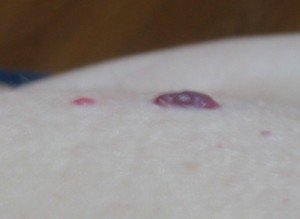
A mole that appears to be elongating or stretching out may make you fear melanoma.
So in an attempt to reassure yourself, you convince yourself that normal moles can be stretched permanently if the skin has been stretched.
There’s the case of a woman who began noticing that a mole on an inner thigh was looking longer than usual – a stretched appearance.
She described it as more elongated than usual.
One of the guidelines in checking for melanoma is that of “evolving.”
So if a mole begins looking as though it’s getting longer, even if nothing else about it has been changing such as color or border regularity, this should be brought to the attention of a doctor.
She was trying to convince herself that recent weight gain or pulling at the skin with her fingers to view the mole had left it in a permanently stretched state.
“It is normal for a mole to grow with you, if you’re growing,” says Estee Williams, MD, a board certified medical, cosmetic and surgical dermatologist and assistant clinical professor in dermatology at Mount Sinai Medical Center.
Dr. Williams explains, “For example, children, teens and adults who have gained weight from pregnancy or otherwise, may notice that all their moles look a bit bigger.”
The increase in size can be uniform or ovular.
“It is still recommended for every adult to have an annual skin cancer screening, from head to toe.”
You cannot permanently stretch a mole with your fingers pulling at the skin around it.
Though this can cause a very noticeable elongation WHILE your fingers are maintaining the stretched position of the skin, the mole will instantly revert to its normal shape once you release the skin.
If you keep checking the mole this way, pulling at the skin to get a better or more head-on view of it, this still will not permanently stretch out the mole.
If your moles appear to be stretching or changing in any way, you can seriously up the ante of your skin cancer surveillance by employing a technology called serial digital dermoscopy.
This state-of-the-art technology is available at Dr. Williams’ clinic, and involves annual photos of your moles taken and fed into a computer database, where an algorithm determines a melanoma-suspicion index for each mole.
Images are also compared to previous ones to see if there are any changes over time, such as a mole appearing to be getting longer or stretched out.
Melanoma CAN make a mole look longer.
When in doubt, have the spot checked out by a dermatologist. If you feel uneasy, even if the assessment is “It looks benign,” request a biopsy.



























